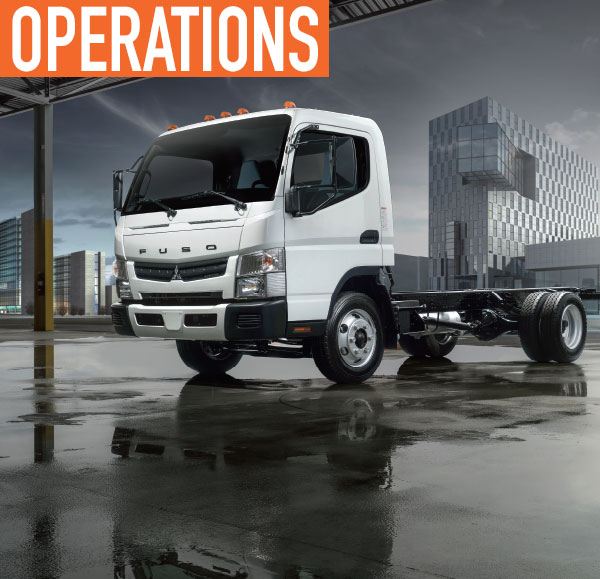In recent years, fleets have had the opportunity to purchase a growing variety of technology options for their truck transmissions that maximize fuel economy and lower operating costs. Some of those advancements are now becoming a standard offering.
However, few customers inquire about such fuel economy advances when they walk in the showroom at Tri Truck Centre, in Barrie, Ontario.
“If I have 100 customers, three or four may bring it up,” says Thom Moody, sales manager at a high-volume Hino dealer. “With the exception of some of the large, savvy fleets, most people don’t understand it. It’s still relatively new.”
Fortunately for those customers, OEMs such as Hino and Mitsubishi Fuso are beginning to offer fuel efficiency packages as a standard feature. Driving this trend are increasing environmental regulations and a desire among OEMs to enhance their value proposition.
THE ANSWER
At The 2018 Work Truck Show in Indianapolis, Fuso revealed its Class 4/5 gasoline-powered FE Series cab-over-engine model, equipped with a fully automatic Allison 1000 Series™ transmission, featuring FuelSense 2.0® with DynActive™ Shifting as standard equipment.
Through a set of proprietary software enhancements, the FuelSense 2.0 technology uses DynActive Shifting to provide an infinitely variable combination of shift points to deliver up to 6 percent additional savings beyond original FuelSense. The software uses a learning algorithm to continuously find the ideal balance of fuel economy and performance for each operator’s specific duty cycle.
“Fuso is electing to make the FuelSense 2.0 a standard feature on our trucks, which will benefit the operator with improved fuel efficiency,” says Bryan Allen, marketing manager for Mitsubishi Fuso Truck of America.
Another OEM offering FuelSense 2.0 with DynActive as standard equipment is Toyota-owned Hino, for its Allison-equipped trucks.
Allison, the world’s largest producer of fully automatic transmissions for commercial-duty vehicles, first introduced FuelSense in 2014 amid a crowd of new fuel innovations in the heavy truck market. Some of those are exotic and pricey.
Today, a typical truck OEM’s brochure offers a dizzying variety of smart features such as telematics and buzzwords such as “case management” and “business intelligence.” It can all be a bit too much to absorb for a truck buyer who hasn’t visited a showroom in several years.
“That doesn’t mean that innovative fuel-savings packages for transmissions don’t offer measurable benefits for the end user,” Moody says. “To me, if a company is willing to put this into their product that means they have confidence in what the numbers are going to spit out.”
FUEL ECONOMY
But not only are some truck buyers not aware of the latest fuel saving technologies, fuel economy may not even be at the top of their list. A consideration such as cargo capacity, durability, engine size, box configurability, or even monthly payments may trump all.
“If a customer is concerned about the lifecycle cost of the truck, then fuel economy is part of the equation,” says Gordon Moore, vice president of McCormick Motors, a five-brand truck dealer in Nappanee, Indiana. “If they’re just concerned about the price of the truck, then it may not be.”
Indeed, that a customer might not otherwise choose an optional fuel-saving package underscores the value of truck OEMs making such options standard equipment.
Even when customers are more focused on price or other considerations, the fuel economy advantages provide sales staff a conversation point into the other advantages of Hino trucks, Moore adds.
“Hino has the data to back up their fuel economy leadership, and Allison is part of that story,” Moore says. “Coupled with that is the reliability of the entire powertrain. Our history with Allison is it’s a bulletproof transmission.”
BOOSTED FEATURES
Allison has made its fuel economy software available in three packages: FuelSense 2.0, FuelSense 2.0 Plus, and FuelSense 2.0 Max. All three include DynActive Shifting.
FuelSense 2.0 Plus and Max include improved “Neutral at Stop.” This feature lowers fuel consumption and emissions by reducing or eliminating the load on the engine when the vehicle is stopped. A new version provides low-speed coasting capability.
FuelSense 2.0 Max includes enhanced “Acceleration Rate Management,” which mitigates aggressive driving by automatically controlling engine torque.
As fuel-saving technologies evolve, companies such as Allison have found some flavors are well-suited to particular vocations. For example, providing maximum value for applications with heavy start-stop needs, FuelSense 2.0 is ideally suited for refuse, construction, and distribution. Customer fleets representing a variety of duty-cycles have experienced fuel economy gains up to 6 percent. This fuel economy improvement resulted in estimated per vehicle savings of $300 to $900 annually based on application, annual mileage, and fuel price.
IMPLEMENTATION
Autocar Trucks was the world’s first truck manufacturer to provide the technology, in both diesel and CNG applications, and for both Allison 3000 Series™ and 4000 Series™ transmissions.
“A typical garbage truck burns 10,000 gallons of fuel a year. With FuelSense 2.0 Max, our customers can save over $1,500 per year in fuel costs at the current price of diesel,” says Jim Johnston, president of Autocar. “That’s money that goes straight to the bottom line.”
Meanwhile, Prevost/Nova Bus recently announced that FuelSense will be available on its vehicles beginning this month.
“Much of Allison’s success has come from building transmissions tailored to specific applications rather than a one-size-fits-all approach,” says Heidi Schutte, vice president of marketing and sales for the Americas with Allison Transmission. “With FuelSense 2.0, we’ve taken this customization to a new level, giving vehicle builders more flexibility to offer the right blend of performance and fuel economy for their specific application.”
FOR MORE INFORMATION
Find out more, visit www.allisontransmission.com.
MODERN WORKTRUCK SOLUTIONS: APRIL 2018 ISSUE
Did you enjoy this article?
Subscribe to the FREE Digital Edition of Modern WorkTruck Solutions magazine.
![]()





